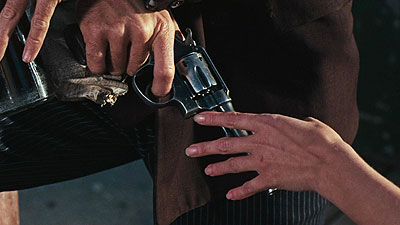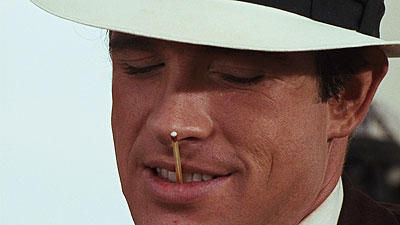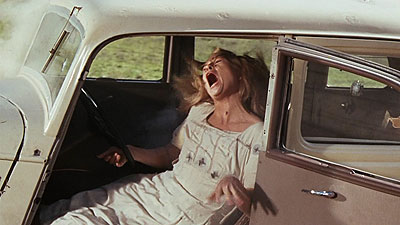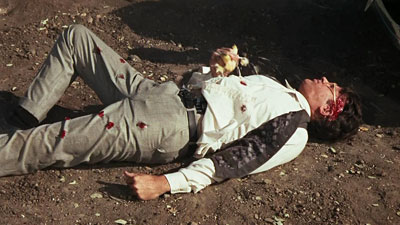Bonnie and Clyde: “You Made Me Somebody They’re Gonna Remember”
Published on January 30th, 2012 in: Critics/Criticism, Issues, Media, Movies, Oh No You Didn't |“Why? What’s you mean, ‘Why?’ Because you’re different, that’s why. You know, you’re like me. You want different things. You got somethin’ better than bein’ a waitress. You and me travelin’ together, we could cut a path clean across this state and Kansas and Missouri and Oklahoma and everybody’d know about it. You listen to me, Miss Bonnie Parker. You listen to me.”
—Bonnie and Clyde, 1967


Screencaps from The Thought Experiment
In 1967, the Hays Production Code was on its last, trembling legs. It had been established in the 1920s, and headed by ultraconservative Will Hays (President Harding’s Postmaster General), whose main task was “to stave off the threat of government censorship by mollifying pressure groups, managing news, deflecting scandal, and generally discouraging close scrutiny” of the motion picture industry. (1) In the ’30s, when sound became the latest facet of films which could potentially promote vulgarity, the Hays Office created the “Production Code.” The code was, says film historian David A. Cook, “awesomely repressive” in terms of dictating how movies depicted any sort of sexual act, the usage of profanity, drug use, excessive drinking, religious criticism, surgical operations, and more.
Continues Cook:
“But the Code’s most labyrinthine strictures were reserved for the depiction of crime. It was forbidden to show the details of a crime, or to display machine guns, submachine guns, or other illegal weapons, or to discuss weapons at all in dialogue scenes. It was further required that law enforcement officers never be shown dying at the hands of criminals and that all criminal activities within a given film were shown to be punished. Under no circumstances could a crime be shown to be justifed.” (2)
(To read the entirety of the 1930 version of the Code, go here. To view all later amendments and revisions, go here.)
During this time period, there was no ratings system. Studios which belonged to the Motion Picture Producers and Distributors of America (MPPDA, later called the MPPA) could not distribute or release a film without a certificate of approval signed by Joseph I. Breen (the Catholic head of the Production Code Adminsitration) and featuring the PCA seal. The PCA held sway over the movie industry for decades, until it became “basicially unenforceable” in the mid-fifties. (3) Yet, there was still no ratings system.
It was in this milieu that Bonnie and Clyde was created. Bonnie and Clyde broke just about every rule established by the Code, particularly in its depiction of crime. Details of a crime? Check. Machine guns, submachine guns, ilegal weapons, and the discussion of them? Check. Law enforcement officers dying at the hands of criminals? Check. Oh, sure, criminal activities were punished in the end, but even that was done with a level of violence previously unseen in movies, as the titular characters are gunned down in a maelstrom of bullets. Bonnie and Clyde was certainly not the first film to flout the Code’s requirements, but it may have been the most contentious in terms of critical reception.
The film was first screened on August 4, 1967 at the Montreal Film Festival. When it opened in the US about a week later, it invoked the wrath of Bosley Crowther, the film critic for The New York Times. “It is a cheap piece of bald-faced slapstick comedy that treats the hideous depredations of that sleazy, moronic pair as though they were as full of fun and frolic as the jazz-age cutups in Thoroughly Modern Millie.”
But Crowther wasn’t done. He wrote another scathing review, published on September 3, 1967. Still, Crowther felt compelled to continue. According to film historian B.J. Leggett:
“In fact, he managed to damn Bonnie and Clyde in seven separate reviews between August 7 [sic], the day after it was first shown at the International Film Festival of Montreal, and December 17. Four of these are substantial discussions (the most extended a defense of his original judgment directed to angry letter-writers); in the other three, Bonnie and Clyde is inserted, to its disadvantage, into discussions of other films.”(4)
Roger Ebert discussed Crowther’s near-obsession with Bonnie and Clyde in a December 10, 1967 column, stating, “Last week, it was announced that Crowther will retire.”
There was another critic who devoted no fewer than 9,000 words to Bonnie and Clyde: Pauline Kael. Kael had criticisms of the film, but unlike Crowther she felt it was “a work of art”:
“‘Bonnie and Clyde’ brings into the almost frighteningly public world of movies things that people have been feeling and saying and writing about. And once something is said or done on the screens of the world, it can never again belong to a minority, never again be the private possession of an educated, or ‘knowing’ group. But even for that group there is an excitement in hearing its own private thoughts expressed out loud and in seeing something of its own sensibility become part of our common culture.”
At the time Kael was a freelance writer, but in 1968, she was hired as The New Yorker‘s film critic, a position she would hold until 1991, along the way becoming one of the most influential American film critics.
Other big changes took place in 1968. On November 1, Jack Valenti, who was the president of the MPAA in 1966 announced the “birth of the new voluntary film rating system of the motion picture industry.”


Screencaps from The Thought Experiment
Bonnie and Clyde was nominated for nine Academy Awards and won two of them. Beatty, who had to beg Warner Bros. to release the film in the first place—and who agreed to a $2M salary and 40% of the gross—ended up making $30M when the film became a box office sensation.
In an L.A. Times piece commemorating the movie’s 30th anniversary, Beatty said:
“The great thing about ‘Bonnie and Clyde’ was that it gave me a freedom I’ve never relinquished. It gave me the confidence to know that if I wanted to make a movie, I could just go out and make it. There are some movies where you didn’t always know what went on or whose idea it was—everything just comes together. It’s like Victor Hugo said, ‘There’s nothing as powerful as an idea whose time has come’.”
Sources:
2. Ibid.
4. Excerpt from B.J.Leggett, “Convergence and Divergence in the Movie Review: Bonnie and Clyde,” Film Criticism 30:2 (2005-06): 1-23.
One Response to “Bonnie and Clyde: “You Made Me Somebody They’re Gonna Remember””
February 7th, 2012 at 1:45 pm
GREAT article! Great movie. I remember seeing it, not in 1967, but not much later, maybe at the drive-in. It was a powerful film at the time, unprecedented.
Time limit is exhausted. Please reload the CAPTCHA.